‘Aloha Kitchen’: Cookbook Author Alana Kysar Shares Her Favourite Recipes

Kysar provides insights on how Hawaii’s multiethnic culture — native Hawaiian, Chinese, Japanese, Portuguese, Korean, Filipino and Western, in particular — and culinary heritage have influenced local foods. Photo: Joan Kysar
When Alana Kysar moved to San Diego for university, she yearned for the flavours of her native Hawaii. Inspired by her Japanese American heritage and a life volleying between southern California and the Aloha State, Kysar started her food blog Fix Feast Flair back in 2015. Several years later, she released her debut cookbook, Aloha Kitchen: Recipes From Hawai’i, which quickly topped many cookbooks lists and even became a finalist for an International Association of Culinary Professionals Cookbook Award. Through 85 easy-to-follow recipes of local favourites and staples, including plate lunches, loco moco, shaved ice and saimin, Kysar provides insights on how Hawaii’s multiethnic culture — native Hawaiian, Chinese, Japanese, Portuguese, Korean, Filipino and Western, in particular — and culinary heritage have influenced local foods.
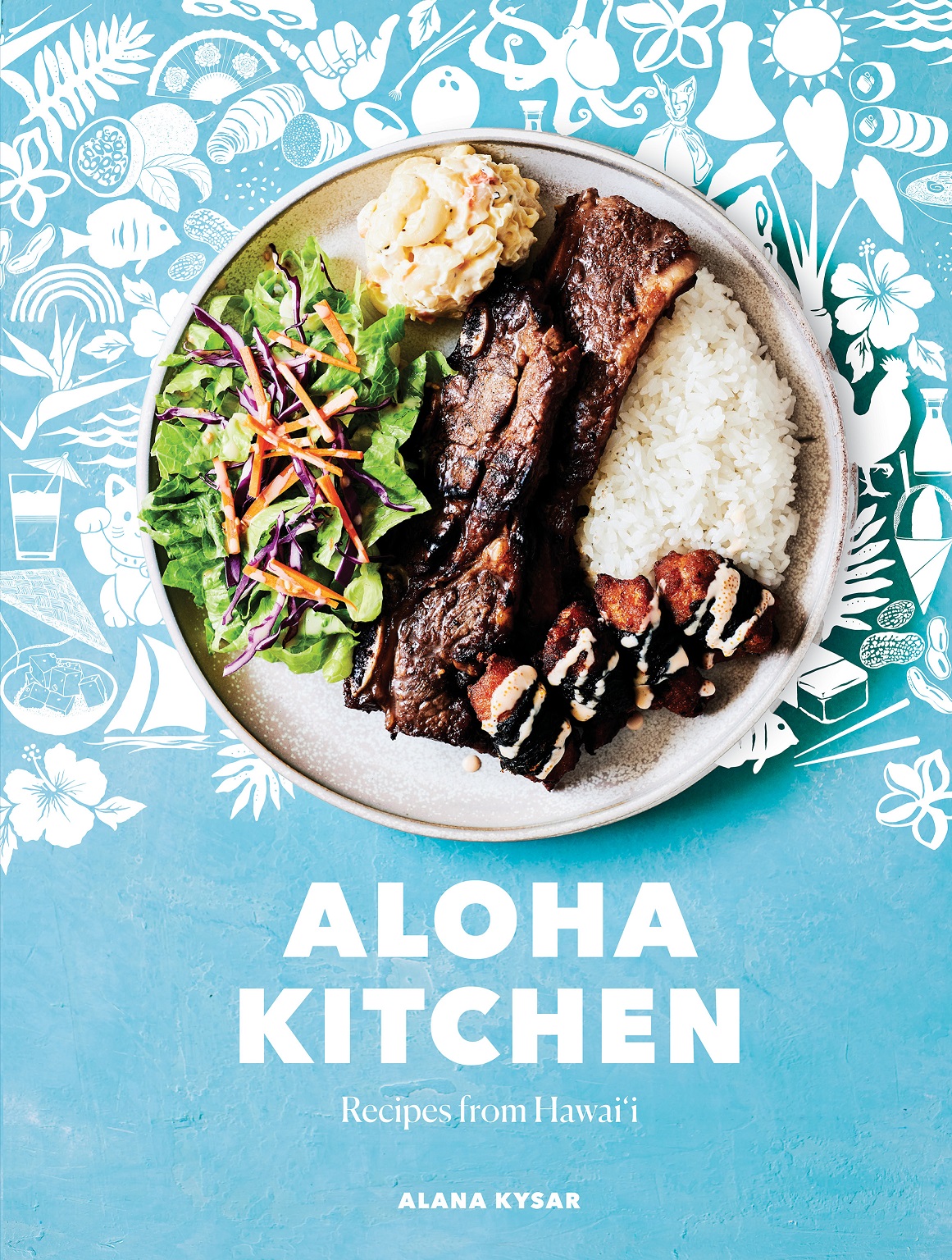
Zoomer caught up with Kysar to talk about the flavours and traditions she writes about in her ode to homestyle local foods. We also serve up recipes for Butter Mochi, Mochiko Chicken and Potato Mac Salad — favourites of the author — that you can try at home. E ʻai kāua!
What inspired you to write Aloha Kitchen?
I wrote the cookbook because I missed the flavours of home, but I also wanted to correct misconceptions. I wanted to shed light on this beautiful food culture that we have in Hawaii where we embrace all these different ethnic groups. It’s part of our history. A lot of these groups came over to work on the plantations, primarily sugar and pineapple, and they [spoke] different languages. And, I think, the goal of the plantation owners was to keep [these groups] separate, but food was a bridge that they connected through … which is why it’s so beautiful to see it celebrated today. I think it’s a very special and unique place where it’s not just Japanese, Chinese or Hawaiian; we have all these different groups equally represented.
When I moved to California, I realized very quickly that people associated local Hawaii food specifically with pineapple or salmon. It’s such a misconception because pineapple’s from Australia. We did grow it for a period, but it really wasn’t integrated into our food culture. So, I wanted to bring awareness to the dishes that I grew up loving and that so many people [in Hawaii] love as well.
This book is, in many ways, a love letter to Hawaii. My goal was to embody everyone on one page; I wanted everyone to feel seen when they saw the book. If you were from Hawaii, or if you had a connection to Hawaii, I wanted something in it to trigger a wonderful memory for you. So that was really important to me.
How did you curate the recipes included in the cookbook?
The recipes are a combination of my experience and anyone who lives [in Hawaii] as well. There are recipes that I grew up enjoying. My mom’s an excellent cook and made a lot of these dishes at home, but [when I was] developing the recipes for the cookbook, I actually spoke to every single person I could possibly speak to with ties to Hawaii. If I was at home on a research trip, I would talk to my Uber driver, my dentist or ask everyone ‘What are the recipes that you love? What embodies local Hawaii food for you?’ So, I hope it was thoughtfully curated to embody everyone’s experience.
Which recipe was non-negotiable?
The most important recipe is Mochiko Chicken. Growing up, my mom made this amazing mochiko (sweet rice flour) chicken only for special occasions like a school field trip where she would pack a lunch for me or for a potluck. Mochiko Chicken is essentially chicken that is marinated in a mochiko-based marinade and then you fry it. I think frying is love. It wasn’t an everyday thing because you do have to plan ahead since you do have to set things up, the chicken is ideally marinated overnight and you have to take the time to fry. It’s really my mom’s recipe and I tried my best to improve upon it. It’s the best dish and so simple and easy to make, outside the frying element.
Given the variations possible with many of the homestyle recipes, how did you choose what version to immortalize in the pages of Aloha Kitchen?
Everyone has their own interpretation of a dish and I made sure to read up on everyone’s interpretation. I looked through a lot of old cookbooks. It was really cool because they were from a 4-H club or something a school put together that was spiral bound, so they had a very mom and pop kind of feeling. Then I took what I knew about the dish and made the most accessible and approachable version.
Since some of the dishes featured could be regionally specific, how hard is it to reproduce outside of Hawaii?
I wrote the recipes as if I were writing them for a friend who told me she didn’t know how to cook. It was very important to me to make the language as clear and approachable as possible. Most of the dishes are very accessible, using ingredients that can be found in supermarkets anywhere or some you can source on Amazon like li hing mui powder [made from sweet and tart dried plums that are preserved in licorice, salt and sometimes aspartame].
[However], part of the goal was to stay authentic, so some of the dishes you won’t be able to make outside of Hawaii. [For example], the holly fern salad, which I feel really is such a special dish, but it’s very hard to find outside of Hawaii and in parts of Asia. It’s basically a young fern shoot that you forage. It’s quickly blanched and then you make a marinade that you toss it with. It’s delicious, and there’s nothing quite like it. I do think that a substitution could be made with a mix of green beans and some okra to kind of mimic the crunch and slight slime effect.
I also have a recipe for fried fish, which you can have here all the time, but I don’t expect it’s very easy to find reef fish outside of Hawaii.
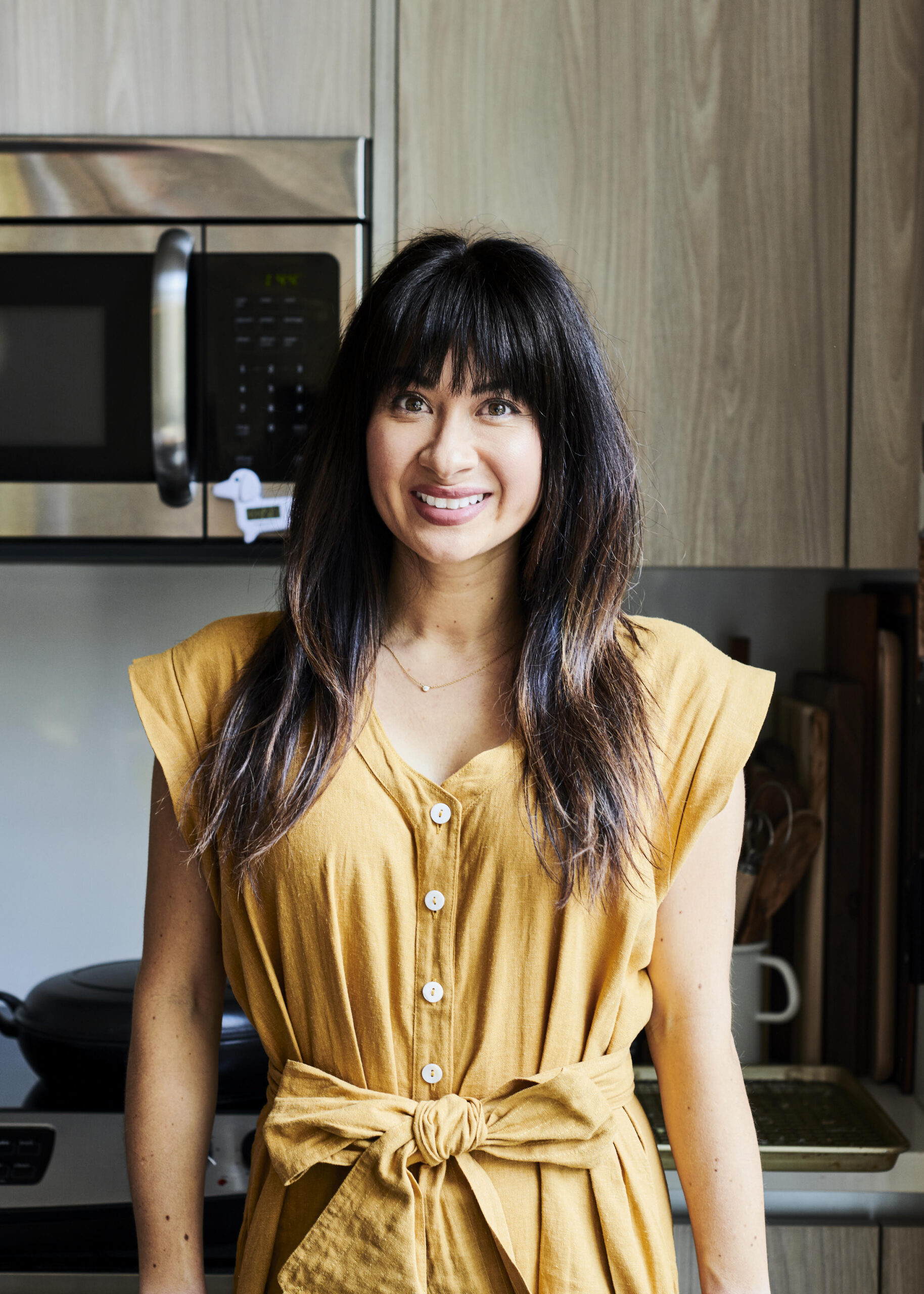
What recipe do you hope that readers will try?
I think that everyone should try Butter Mochi. I feel like it is something that is uniquely Hawaiian but also has been very well received everywhere else. It’s almost kind of trendy and cool now.
It’s a great thing to make because it’s gluten free. And there’s really not anything to dislike: it’s butter and sugar. And it has this wonderful kind of springy texture that’s almost custardy on the inside, and if you don’t cook it too long, the crust kind of melts. The full experience is beautiful.
You can make it in a 9 x 13-inch pan. Typically it’s made for potlucks. That’s why the recipe is so large. It’s usually the first thing to go on the dessert table. You can also pack it in your lunch or for a picnic. I describe it as a mochi bar. Some people call it a mochi cake.
Every kid in Hawaii knows this dish. And it’s great because it’s easy to make. It uses sweet rice flour (mochiko) and that’s a crucial ingredient. You can’t make a substitution with normal rice flour, it’s the sweet rice flour that gives you the springy texture. Nowadays, you can find mochiko everywhere, like in the Asian section of the supermarket.
Can you comment on the mix of flavours found in Hawaiian food?
In Hawaii, we have an eclectic pantry, which is why the book features a pantry section. It’s a little bit of everything: Japanese, Chinese and Filipino … I didn’t realize that I had a unique pantry until I had a friend who’s also in the food space come over to my kitchen when I was living in California and she was like, ‘What are all these ingredients?’
When I think about Hawaii, I think about the plate lunch, which is not a unique thing but it’s something you can get at a spot that just sells plate lunches. There’s always some kind of protein or if you’ve got a mix plate, then you’ve got two or three kinds of protein. There’s a starch, which is always steamed white rice, and then you have a kind of mealy starch, which is the mac salad or the potato mac salad. Sometimes there can be a mixed green salad or some pickles and things like that, but typically it’s protein and starch.
I think that everyone should try the Potato Mac Salad. It’s very special to me, because I think my mom makes the best potato mac salad. Her secret is grated raw onion and that really adds the perfect pop of flavour. I get notes from California to Kansas City and they all rave about it. It’s good for a potluck. So you’ve got mochiko chicken, potato mac salad and butter mochi. All you need is to cook some rice and you’ve got a mix of what homestyle Hawaii food is.
What would you like our readers to know about these recipes?
I hope that they’ll find that these dishes are very universal. They’re oftentimes dishes that everyone can make at home. I love that local Hawaiian food is very cosy and comforting; it’s home cooking, which I think everyone can appreciate.
What has been the most meaningful thing for you from writing Aloha Kitchen?
I think that a lot of people are starting to realize that there are so many similarities in our local food culture to their own culture. We have beef stew and beef chili, and that’s super common to everyday cooking here. It’s a slightly different version, but it’s something you can find all the ingredients and try.
Another thing with the book, if you have a physical copy, is the paper which was specifically selected so that you can write notes in it because I want this book to become your book. At the end of the day, I want these recipes to feel like your recipes. I want you to write the things that you change to make it better, because I hope that this will be passed on to a future generation.
This Q&A has been edited for clarity and length.
RECIPES
Butter Mochi
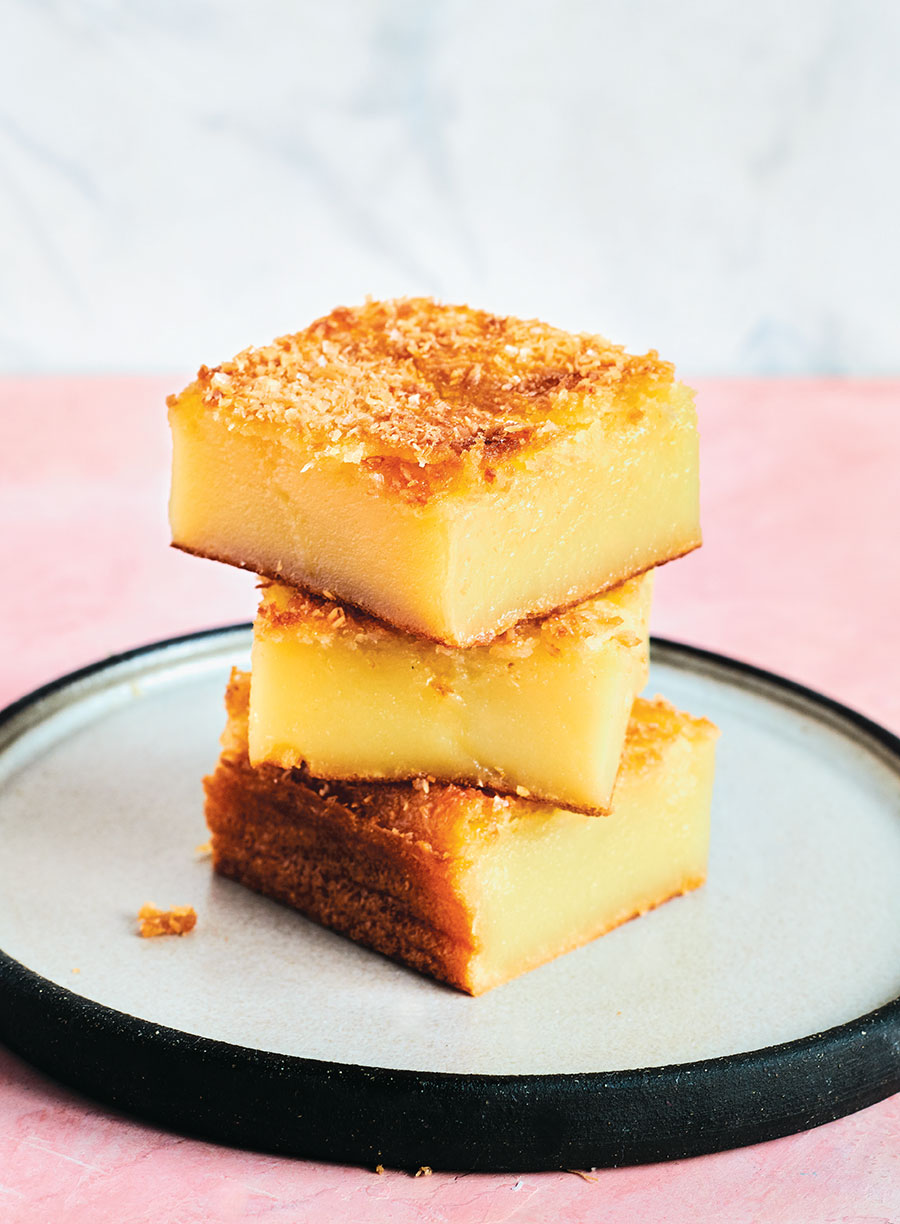
Butter mochi is a mainstay at any island party. You can see why: it’s like a perfectly chewy, slightly sticky, and just-dense-enough coconut- custard glutinous rice cake. What I love about it is how it evolves over the course of twenty-four hours. The first day it’s got this gorgeous, golden brown, crispy, crunchy crust that magically transforms into a soft, almost melty crust the next day. While you can halve the recipe,
I doubt you’ll want to after trying a bite!
Makes 20 pieces
Ingredients:
4 large eggs
2 teaspoons (10 ml) vanilla extract
2 cups (500 ml) skim milk
1-pound box mochiko flour
2 cups (400 g) sugar
2 teaspoons (10 g) baking powder
½ teaspoon (2.5 g) kosher salt
½ cup (125 g) unsalted butter, melted
13½-ounce (400 ml) can coconut milk
½ cup (113 g) unsweetened shredded coconut
A few pinches of flaky salt (optional)
Directions:
- Preheat the oven to 350 F. Grease a 9 x 13-inch baking pan with butter or oil.
- In a bowl, whisk together the eggs, vanilla, and milk. In another larger bowl, whisk together the mochiko, sugar, baking powder, and kosher salt. Pour the wet ingredients into the dry ingredients and, with a wooden spoon, stir until well combined. Add the melted butter and coconut milk and mix until fully incorporated.
- Pour the mixture into the prepared pan and rap the pan on the counter a couple of times to bring any air bubbles up to the surface. Evenly sprinkle the shredded coconut on top of the mixture, a handful at a time, being careful not to jiggle the pan too much, as you want the coconut to stay on the top. Then sprinkle on a few pinches of flaky salt, if desired.
- Bake until the mochi is set and golden brown on top, about 1 hour.
- Set the pan on a wire rack and let cool completely before slicing into rectangles using a plastic knife to minimize sticking. (Kysar cuts the butter mochi into four columns and five rows to make twenty 2¼ x 2½-inch pieces.) If the knife seems to be sticking, rub it with a little unsalted butter or neutral oil. Store in an airtight container at room temperature for up to 3 days.
Potato Mac Salad
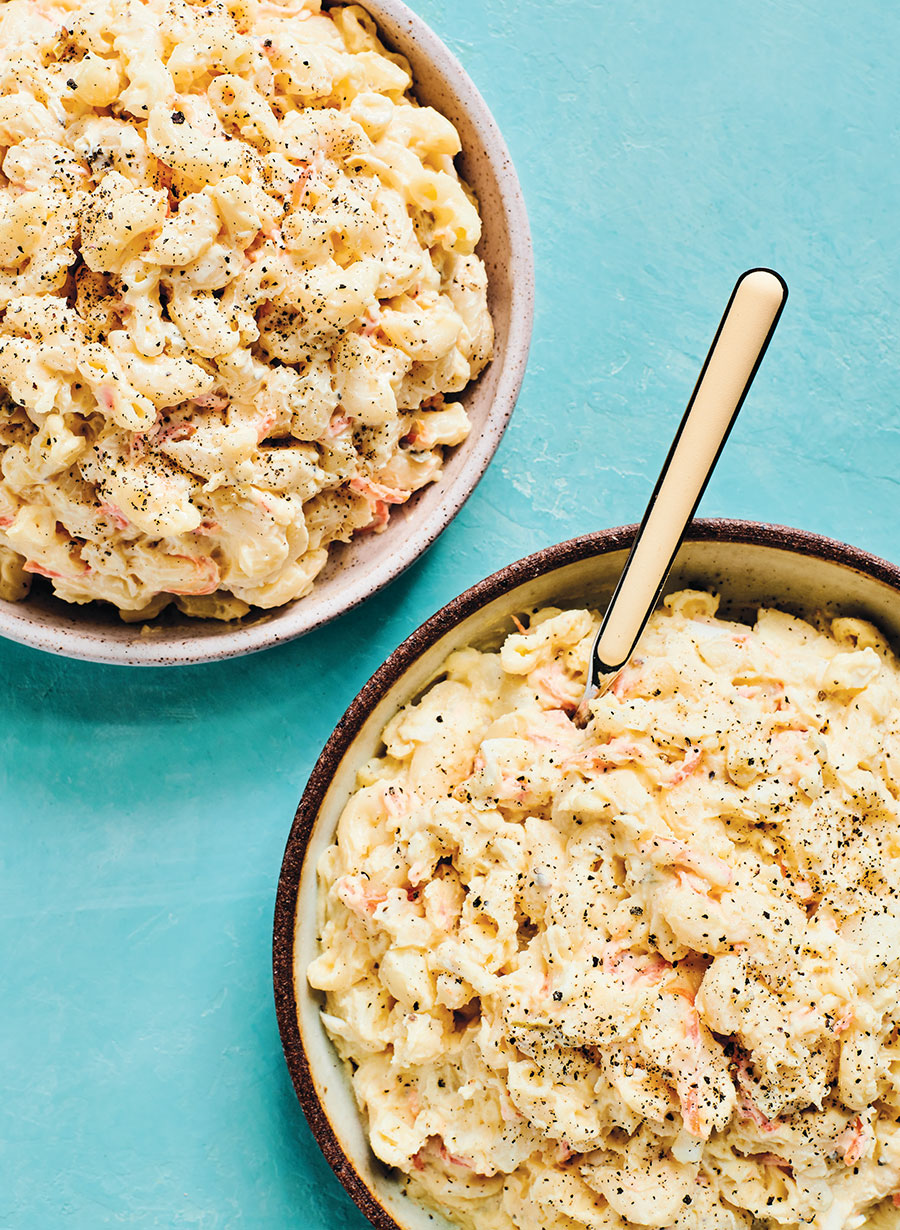
“I’m obsessed with Hawaiian mac salad!” I can’t tell you how many friends from the mainland have said this very sentence to me. It’s usually followed by “What’s the secret ingredient?” Well, I think the answer is grated onions. Yes, pull out your box grater and grate your onions with the small grate side, making sure to add all the liquid goodness that weeps out. You want your onions to be almost liquefied to get that Hawai‘i-style mac salad flavour. This salad is served with almost every plate lunch and at most family gatherings. There are many variations— with green onions, peas, chopped ham, or even tuna—but this recipe makes a good basic island-style mac salad. And because it’s my favorite, I’ve also included a variation with potato and hard-boiled eggs.
Serves 6 to 8
Ingredients:
Kosher salt
3 medium russet potatoes, peeled and cut into 1-inch cubes
8 ounces (2 cups or 227 g) dry elbow macaroni
4 large hard-boiled eggs, peeled and coarsely chopped
3 tablespoons grated Maui or yellow onion (roughly ⅓ whole onion)
1½ to 2 cups (375 to 500 ml) mayonnaise (Kysar recommends Best Foods or Hellmann’s)
3 tablespoons (45 ml) sweet pickle juice
¼ cup (60 ml) sweet pickle relish
Freshly ground black pepper
¼ cup coarsely grated carrot (about ½ medium carrot)
Directions:
- Bring a large pot of water to a boil over high heat, then add 2 tablespoons kosher salt and the cubed potatoes. Turn the heat to medium-high and cook until fork-tender, 10 to 12 minutes. Drain and transfer to a large bowl.
- Meanwhile, cook the macaroni, salting the water with 2 tablespoons kosher salt, according to the instructions on the package, until very tender, not al dente. Drain and add to the bowl with the potatoes. Let cool slightly for 10 minutes, then add the eggs, onion, 1 cup of the mayonnaise, the pickle juice, relish, and pepper to taste and toss until well coated. Taste and season as needed with salt and pepper. Chill for 1 hour.
- When ready to serve, stir in ½ cup of the mayonnaise and the carrot; add more mayonnaise if it looks dry. Taste and adjust the seasoning as needed. Serve chilled.
Mochiko Chicken
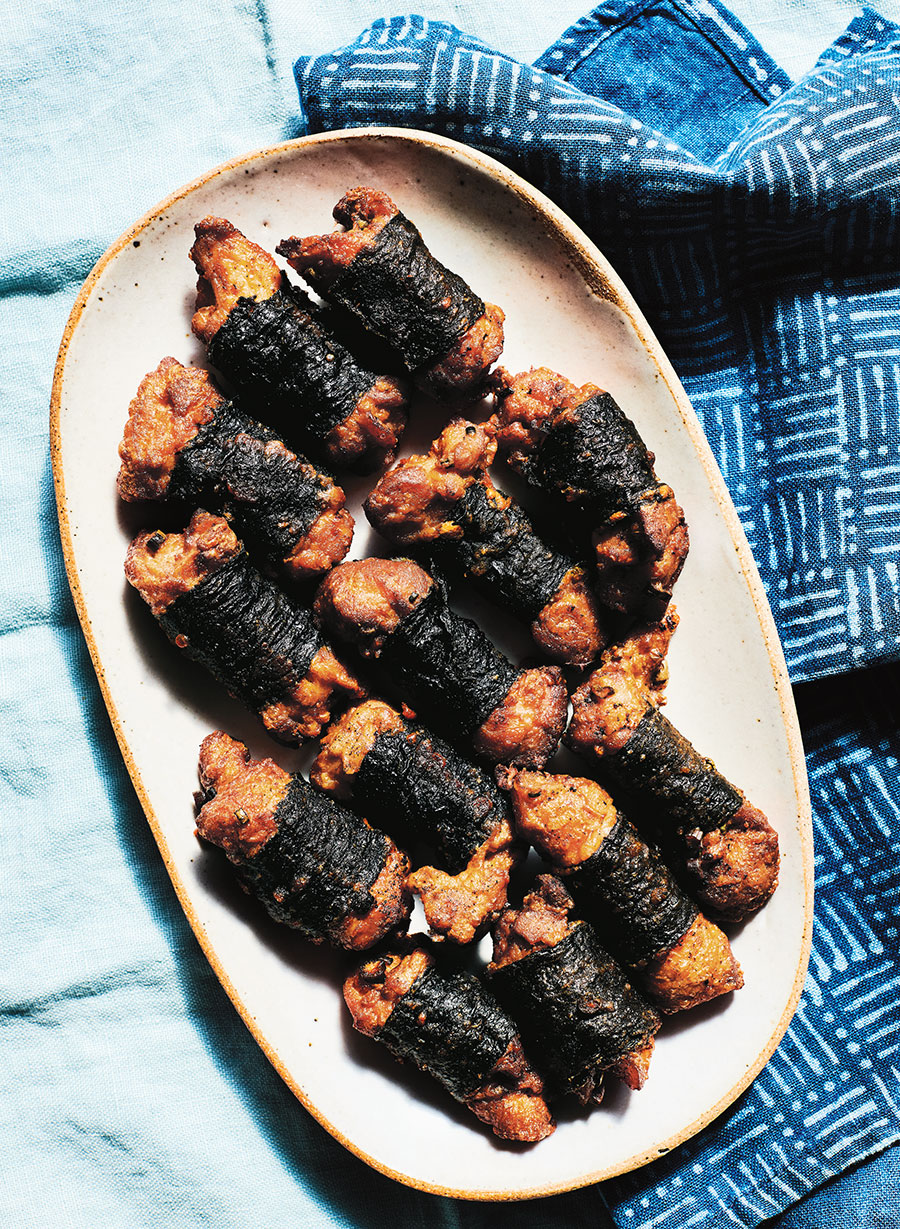
There’s nothing quite like fried chicken. It’s crispy on the outside, juicy on the inside, and, when done right, packed with flavour. I think it’s safe to say that most places have their own version, and Hawai’i is no exception. This sweet rice flour–battered chicken is perfectly crunchy, salty-sweet, and highly addictive. It’s one of my all-time favorite dishes, and I’m taken back to my childhood every single time I have it. While I believe it’s best served warm with onigiri (aka triangle-shaped musubi), Namasu (page 68), and Takuan (page 69), the way my mom serves it, it’s equally great cold, chopped up, and tossed into a green salad with Creamy Asian Dressing (page 217) or atop a bed of cold somen noodles.
Serves 6 to 8
2 pounds (900 g) boneless, skinless chicken thighs
¼ cup (38 g) mochiko flour
¼ cup (30 g) cornstarch
¼ cup (50 g) sugar
¼ cup (60 ml) soy sauce (shoyu)
½ teaspoon (3 g) kosher salt
2 large eggs, beaten
¼ cup chopped green onions, both white and green parts (about 4 green onions), plus more for garnish
Neutral oil, for frying
2 garlic cloves, peeled and extra finely grated
3 to 4 sheets nori, cut into 1-inch wide strips (optional)
3 cups (375 g) steamed rice, for serving
Directions:
- Cut the chicken thighs into 2-inch-long strips and place them in a bowl.
- In a small bowl, combine the mochiko, cornstarch, sugar, soy sauce, salt, eggs, green onions, and garlic, and whisk until fully combined. Pour the batter mixture over the chicken and mix to coat evenly. Marinate in the refrigerator for at least 5 hours, preferably overnight.
- Line a baking sheet with paper towels or newspaper and place a wire rack on top.
- Fill a Dutch oven or high-sided pot with oil to a depth of 2 inches and heat over medium-low heat to 330 F to 340 F.
- Remove the chicken from the bowl and wrap each piece with a strip of nori (if using).
- Without crowding the pot, add as many pieces of chicken as you can to the hot oil; the temperature will drop to between 315 F and 325 F when you add the chicken. Fry the chicken for 6 to 7 minutes, turning with a skimmer or long chopsticks to brown evenly. The chicken will be golden brown when it’s done and the internal temperature should be 165°F.
- Remove with a skimmer or long chopsticks and let cool on the wire rack for 8 to 10 minutes. Continue this process until all the chicken has been cooked.
- When ready to serve, garnish with freshly chopped green onions and serve with rice.
Reprinted with permission from Aloha Kitchen: Recipes from Hawai’i by Alana Kysar, copyright © 2019. Photographs by Alana Kysar and Brooklyn Dombroski. Published by Ten Speed Press, a division of Penguin Random House, Inc.
RELATED:
A Taste of Hawaii: Delicious Eats and Must-See Sites in Oahu